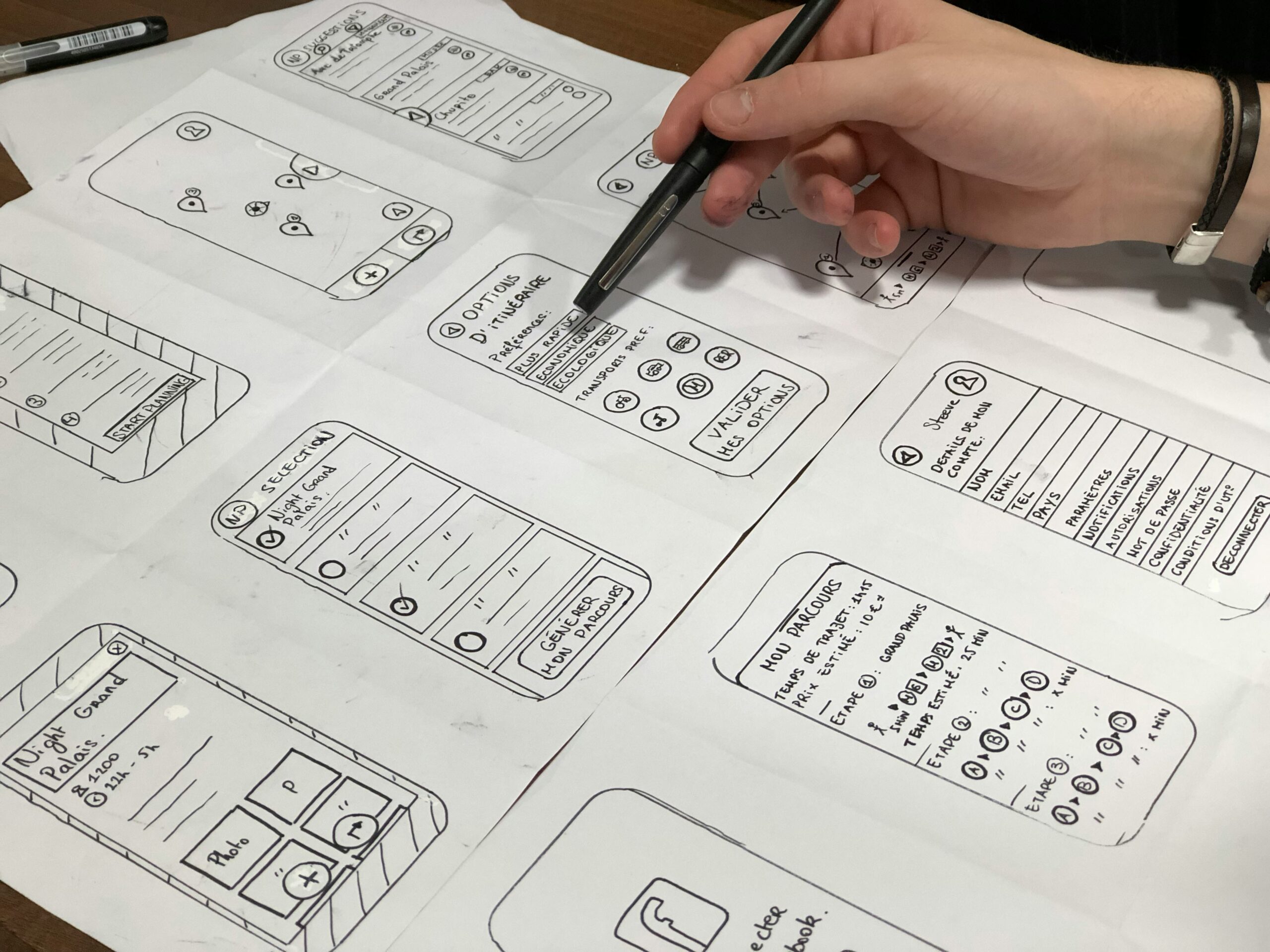
Ideas, Learning, Scripting, Technology, Web Design, Web Development |
Introduction
When it comes to building successful products and websites, user experience (UX) design plays a crucial role. UX design is more than just making things look visually appealing; it focuses on creating a seamless and intuitive experience for users. In this article, we will delve into the importance of UX design as a fundamental step in every project, and how it can significantly impact the success and usability of a product.
The Role of UX Design
UX design involves understanding the needs and expectations of users and designing a product that meets those requirements effectively. It encompasses various aspects such as user research, information architecture, interaction design, and visual design. The primary goal of UX design is to enhance user satisfaction by providing a positive and intuitive experience.
By incorporating UX design into a project, businesses can achieve several key benefits:
1. Improved User Satisfaction
UX design focuses on creating user-centric solutions by understanding user behavior, preferences, and pain points. By conducting thorough user research and usability testing, designers can identify and address potential issues early on in the development process. This leads to a more satisfying user experience and increases the likelihood of user engagement and retention.
2. Increased Conversion Rates
A well-designed user experience can significantly impact conversion rates. By optimizing the user journey and reducing friction points, UX design can guide users towards their desired actions, such as making a purchase or signing up for a service. A seamless and intuitive user experience can boost conversions and ultimately drive business growth.
3. Enhanced Brand Perception
UX design is closely tied to brand perception. A poorly designed and frustrating user experience can leave a negative impression on users, damaging the reputation of a brand. On the other hand, a well-designed and user-friendly experience can enhance brand perception, instilling trust and credibility in users.
4. Cost and Time Savings
Integrating UX design early in the project lifecycle can save both time and resources. By identifying and addressing usability issues early on, businesses can avoid costly redesigns and rework later in the development process. This proactive approach helps streamline the overall project timeline and ensures a more efficient and effective product development process.
The UX Design Process
The UX design process typically involves the following key steps:
1. User Research
Understanding the target audience is crucial for designing a successful user experience. User research involves gathering insights about user behaviors, needs, and motivations through methods such as surveys, interviews, and user testing. This data forms the foundation for creating user personas and identifying user pain points.
2. Information Architecture
Information architecture focuses on organizing and structuring content in a way that is logical and intuitive for users. This step involves creating sitemaps, wireframes, and user flows to define the overall structure and navigation of the product.
3. Interaction Design
Interaction design is concerned with defining how users interact with the product. It involves designing user interfaces, creating interactive prototypes, and ensuring that the product’s functionality aligns with user expectations.
4. Visual Design
Visual design focuses on creating visually appealing and aesthetically pleasing interfaces. It involves selecting colors, typography, and visual elements that align with the brand identity and enhance the overall user experience.
5. Usability Testing
Usability testing is a crucial step in the UX design process. It involves observing users as they interact with the product and gathering feedback on its usability. This feedback helps identify areas for improvement and ensures that the final product meets user expectations.
Conclusion
UX design is an essential step in every project, regardless of the industry or product. By prioritizing user satisfaction, businesses can create products that not only meet user needs but also drive business growth. Incorporating UX design into the project lifecycle can lead to improved user satisfaction, increased conversion rates, enhanced brand perception, and cost and time savings. By following a structured UX design process, businesses can create products that not only look great but also provide a seamless and intuitive user experience.
Remember, UX design is not a one-time step, but an ongoing process. Regularly gathering user feedback and making iterative improvements based on user needs and expectations is key to creating exceptional user experiences.

programing, Technology, Web Design, Web Development |
Web Crawling: Navigating the Digital Web
In the vast expanse of the World Wide Web, information is scattered across millions of websites, each serving a unique purpose and catering to diverse audiences. Navigating this digital landscape to gather relevant data efficiently is a monumental task. This is where web crawling, a fundamental aspect of web scraping, emerges as a powerful tool. In this article, we delve into the intricacies of web crawling, exploring its definition, functionality, challenges, and the ethical considerations associated with this practice.
Understanding Web Crawling
Definition: Web crawling, or web spidering or indexing, is the automated process of systematically browsing the internet to index and collect information from websites. It involves the use of bots or spiders, which are automated scripts designed to follow hyperlinks and gather data from web pages.
How It Works: The web crawling process begins with a list of seed URLs, which are the starting points for the crawler. The crawler accesses a webpage, extracts relevant information, and follows links to other pages. This recursive process allows the crawler to traverse a large portion of the web.
Components of a Web Crawler:
1. Downloader: Responsible for fetching web pages.
2. Parser: Extracts information from the downloaded pages.
3. URL Frontier: Manages the list of URLs to be crawled.
4. Duplicity Handler: Avoids duplicate crawling of pages.
5. Database: Stores the collected data.
Functions and Applications
1. Search Engines:
Web crawlers play a pivotal role in search engine functionality. Search engines like Google, Bing, and Yahoo employ sophisticated crawlers to index web pages. When a user performs a search, the search engine retrieves relevant pages from its index, providing rapid and accurate results.
2. Data Mining:
Businesses leverage web crawling to extract valuable data for market analysis, competitor research, and trend identification. E-commerce companies, for instance, use web crawling to monitor product prices across various platforms.
3. Content Aggregation:
News aggregators and content platforms gather articles and news from diverse sources using web crawlers. This ensures that users have access to a comprehensive range of information on a single platform.
4. Monitoring and Analytics:
Web crawlers are employed to monitor website changes, track user behavior, and gather data for analytics. This is crucial for businesses seeking insights into user preferences and improving their online presence.
Challenges in Web Crawling
While web crawling is a powerful tool, it comes with its set of challenges:
1. Politeness and Ethical Concerns:
Crawlers must be designed to be polite and respectful to web servers. Rapid and aggressive crawling can overload servers, leading to performance issues. Additionally, web crawlers must adhere to ethical standards and respect websites’ terms of service.
2. Dynamic Content:
Websites increasingly use dynamic content loaded through JavaScript. Traditional crawlers may struggle to access and extract data from dynamically generated pages.
3. Handling Different Structures:
Websites vary in structure and format. Crawlers must be versatile enough to navigate and extract information from web page designs.
4. Duplicate Content:
Crawlers need mechanisms to identify and avoid crawling duplicate content, which can waste resources and skew data.
Ethical Considerations
Web crawling raises ethical considerations, especially regarding privacy and data ownership. Some vital ethical principles include:
1. Respect for Robots.txt:
Websites often use a file called robots.txt to communicate with web crawlers, specifying which areas of the site should not be crawled. Ethical crawlers respect these directives.
2. Privacy Concerns:
Crawling personal or sensitive information without consent raises privacy concerns. Ethical web crawlers prioritize user privacy and comply with relevant data protection laws.
3. Data Ownership and Attribution:
Respecting the ownership of data and providing proper attribution is crucial. Crawlers should not be used to plagiarize content or claim it as original.
Conclusion
Web crawling is a dynamic and essential process that underpins various aspects of the digital landscape. As technology evolves, so do the challenges and ethical considerations associated with web crawling. Striking a balance between efficient data extraction and ethical practices is imperative to ensure the responsible and sustainable use of web crawling in the ever-expanding digital realm. As we continue to navigate the complexities of the internet, web crawling remains a cornerstone in the quest for organized and accessible information.

programing, Web Design
JavaScript is a powerful programming language that is crucial in modern website design. It helps developers create dynamic and interactive web pages that engage users and provide an enhanced browsing experience. With its wide range of capabilities, JavaScript has become an essential tool for web designers across the globe.
One of the key advantages of using JavaScript in website designing is its ability to add interactivity. By incorporating JavaScript code into web pages, designers can create interactive elements such as image sliders, drop-down menus, and forms that respond to user actions. This interactivity improves user engagement and makes the website more user-friendly and intuitive.
Another important aspect of JavaScript in website designing is its capability to manipulate the Document Object Model (DOM). The DOM is a programming interface that represents the structure of an HTML document. JavaScript can modify the DOM elements, such as adding or removing content, changing styles, or animating elements. This allows designers to dynamically update the website’s content and appearance without reloading the entire page.
JavaScript also enables designers to implement client-side form validation. With JavaScript, designers can validate user input in real-time without server-side validation. This helps provide users instant feedback, preventing them from submitting incorrect or incomplete data. Additionally, JavaScript can enhance the user experience by displaying error messages or highlighting wrong fields, further improving the website’s usability.
Furthermore, JavaScript offers powerful APIs (Application Programming Interfaces) that allow designers to integrate various third-party services and functionalities into their websites. For example, designers can use JavaScript APIs to integrate social media sharing buttons, embed maps, create charts, or implement video players. These APIs provide a seamless integration of external services, enhancing the website’s functionality and enriching the user experience.
JavaScript also plays a significant role in optimizing website performance. By utilizing JavaScript techniques such as asynchronous loading, lazy loading, and minification, designers can reduce the website’s loading time, resulting in faster and more efficient browsing. JavaScript frameworks like React and AngularJS enhance website performance by providing efficient rendering and state management capabilities.
In conclusion, JavaScript is an indispensable tool for website design. Its ability to add interactivity, manipulate the DOM, validate form inputs, integrate third-party services, and optimize performance makes it a crucial component of modern web design. By leveraging the power of JavaScript, designers can create dynamic, user-friendly, and visually appealing websites that leave a lasting impression on visitors.



